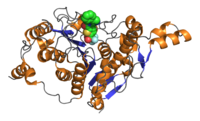
Photo from wikipedia
The abnormal expression of histone deacetylase 8 (HDAC8) has been reported to associate with various cancer entities (colon, breast cancer, pancreas, etc.) as well as parasitic diseases, making HDAC8 gradually… Click to show full abstract
The abnormal expression of histone deacetylase 8 (HDAC8) has been reported to associate with various cancer entities (colon, breast cancer, pancreas, etc.) as well as parasitic diseases, making HDAC8 gradually develop into an attractive and potential therapeutic target. Among the various design strategies of selective HDAC8 inhibitors (modification of Cap, Linker, or zinc binding group regions), the optimization of Cap region has aroused great interest among the researchers. However, the detailed information underlying how the modification of Cap region influences the inhibitory activities is still unclear, and in this study, compounds 2c, 3g, and 3n were selected to explore the differences in binding mechanisms brought by Cap modifications via various computational approaches at the atomic level. Five residues (Y293, H167, D254, D165, and M261) have a large difference in energy contributions to the constructed systems, and the subpocket formed by Y293 and M261 could interact with Cap groups, triggering the differences in the energy contributions of the residues (H167, D254, and D165) located in metal‐catalytic center. In summary, the compounds 2c, 3g, and 3n were selected as molecular probes to explore the binding mechanism, and the residues (Y293 and M261) forming the subpocket should be paid special attention in the design and synthesis of novel selective HDAC8 inhibitors.
Journal Title: Journal of Cellular Biochemistry
Year Published: 2020
Link to full text (if available)
Share on Social Media: Sign Up to like & get
recommendations!